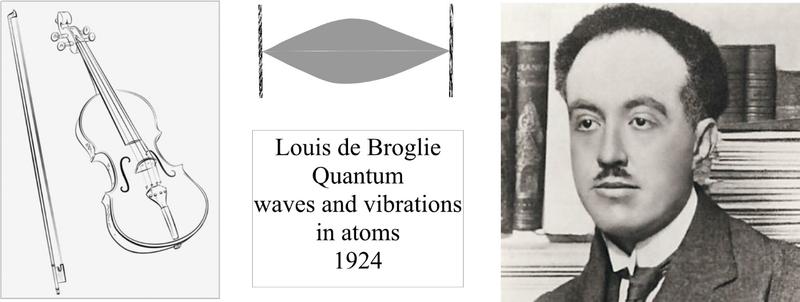Abstract The simple quantitative description of chemical energy as waves hidden in matter is 100 years old. This quantum picture shows electrons resonating as in a musical instrument. Its description of fossil fuel energy applies similarly to nuclear energy. The record of 70 years confirms that the nuclear power is safer than burning fossil fuels, but unwarranted caution has inflated its costs and denied society its benefits – this is not sustainable.

In 1924 a young French PhD student, Louis de Broglie, made a sweeping universal statement for which he received the Nobel Prize in Physics five years later. He said that the behaviour of everything in the physical world should be described by waves. The relevance of these de Broglie waves would have delighted the sages of ancient Greece, familiar as they were with the wave nature of sound. They knew that the dimensions of a resonating string or cavity determined the pitch – the smaller the dimension, the higher the pitch. Indeed, the effect of sound waves becomes obvious with such resonances. What cavities resonate de Broglie waves and what is their pitch?
The de Broglie waves of electrons are contained by the atoms and molecules of matter. Since these are very small, the high pitched energy of the resonating electrons stands out in a world where the effect of de Broglie waves is otherwise hidden in dissonance. The simple energy of an electron described by its de Broglie wave is h2/8mL2 where h is a universal constant found by Max Planck, m the electron mass and L the size of the atom. Putting in the numbers gives an energy of 4 volts – much the same values are found for precise calculations that include all the details. This energy and its variations are the subject of chemistry, electronics and even food energy. In a musical instrument today the acoustic resonator is often replaced by electronics that fulfils the same function in a more versatile way.
So the energy released in the combustion of fossil fuels arises from changes in the wave-like energy of electrons in the atoms and molecules concerned. That energy powered the Industrial Revolution and gave us the extraordinary prosperity that we enjoy today. However, at COP28 the world agreed to reduce its use of fossil fuels. So, what are the options, given that “renewables” are weak and weather dependent?
Fortunately, the story of de Broglie waves has another chapter. As well as electrons, each atom contains a nucleus, 100,000 times smaller. It too is a resonator that contains the de Broglie waves of protons and neutrons. The same energy formula applies unchanged, but now with m being the mass of a proton or neutron and L the size of the nucleus. The energy is then 20 million volts, more than a million times chemical and electronic energies.
Human civilisation has not yet come to terms with this huge, but simple, arithmetical factor. It is interesting to note that in 1931 Winston Churchill wrote an article in the Strand Magazine:
The coal a man can get in a day can easily do five hundred times as much work as the man himself. Nuclear energy is at least one million times more powerful still …. The discovery and control of such sources of power would cause changes in human affairs incomparably greater than those produced by the steam-engine four generations ago.
His numbers are correct, except that another three generations have now passed. Already by the 1950s the technology required to release and control the energy had been discovered and tested. And today we know that nuclear energy is more controllable than fire for reasons that come from both physical science and biology. Life has evolved successfully in a radioactive world. We would not even be here if we were not naturally protected against quite sizeable exposures to radiation.
This conclusion is confirmed by seventy years of evidence in clinical medicine, in laboratory experiments and in the wider environment. The Fukushima Daiichi accident in March 2011 was accepted throughout the world as a major disaster. It precipitated near-panic in Japan and worldwide changes in energy policy. However, the released nuclear radiation caused no casualties – no one was hurt at the time, nor is likely to suffer in future. Evidently these reactions were not justified. The same happened following the accident at Three Mile Island in 1979. At Chernobyl in 1986 there were 28 fatalities from acute radiation syndrome, but no evidence for the thousands of fatalities predicted by experts. And no other radiation accident has recorded a significant loss of life at a nuclear power plant, anywhere in seventy years.
The regulations to restrict exposure to nuclear radiation that have been in place since the 1950s are not justified by evidence. The science of the natural protection from even moderate levels of radiation is well understood, but the relevant public education has been neglected in response to social aversion. Unsurprisingly, the cost, design and planning of nuclear plants have been exaggerated to reflect hypothetical uncertainties. Land use, siting, raw materials, reliability, resilience, security, waste, investment lifetime – all are competitive with other energy sources. But a lack of confidence ingrained by decades of phobia inevitably inflates costs. Nevertheless, commercially funded proposals are already challenging the regulatory status quo. Generally, we may hope that the story of de Broglie and his waves will be taught in schools to inspire future generations.
Wade Allison,Physics Department and Keble College,
University of Oxford, UK.
wade.allison@physics.ox.ac.uk
